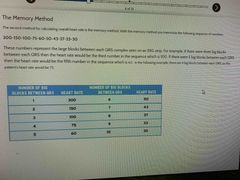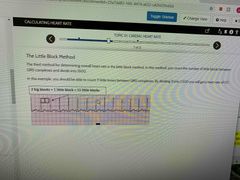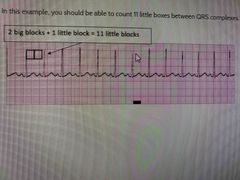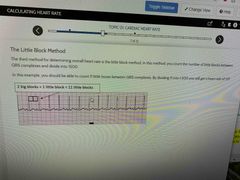![]()
![]()
![]()
Use LEFT and RIGHT arrow keys to navigate between flashcards;
Use UP and DOWN arrow keys to flip the card;
H to show hint;
A reads text to speech;
22 Cards in this Set
- Front
- Back
- 3rd side (hint)
|
Common methods for calculating heart rate from an EKG |
- 6-Second Strip Method - the Memory Method - the Little Block Method |
|
|
|
The 6-Second Method |
- least accurate method -count the number of QRS complexes in a six second strip and multiply by 10 -do not use this method alone |
|
|
|
The Memory Method |

- memorize these numbers: 300-150-100-75-60-50-43-37-33-30 -these numbers represent the large blocks between each QRS complex seen on an EKG strip |
|
|
|
The Little Block Method |

-count the number of little blocks between the QRS complexes and divide into 1500. |
|
|
|
The Little Block Method |

-count the number of little blocks between the QRS complexes and divide into 1500. -calculation is 1500/11=137 |

|
|
|
Rhythm regularity |
-knowing whether or not the patients heart is beating with constancy -to determine if heart rate is constant we measure the R to R intervals between consecutive QRS complexes -to be considered regular, R to R intervals in a rhythm may vary by only 1 to 2 small blocks |
|
|
|
Calculating heart rate with regular rhythm |
-calculate heart rate by choosing any two successive QRS complexes and use the little block method or memory method |
|
|
|
Calculating heart rate with regular rhythm but interrupted by premature beats |
-ignore the premature beats -calculate heart rate using the little block or memory method on an uninterrupted part of the strip |
|
|
|
Calculating heart rate with regular rhythm but interrupted by pauses |
Calculate heart rate from slowest to fastest along with mean rate |
|
|
|
Calculating heart rate with irregular rhythm |
-calculate mean rate by using the 6 second strip method -then calculate heart rate range (slowest to fastest) using the little block or memory method |
|
|
|
Heart rate |
Number of QRS complexes in 1 minute |
|
|
|
Heart rate |
Number of QRS complexes in 1 minute |
|
|
|
Heart rate is same as |
Ventricular rate |
|
|
|
Atrial rate |
Number of P waves in 1 minute |
|
|
|
Heart rate calculations are |
Regularity based |
|
|
|
Regularity |
Refers to the constancy of QRS complexes and/or P waves |
|
|
|
Regularity |
Refers to the constancy of QRS complexes and/or P waves |
|
|
|
R-R interval |
-distance between consecutive QRS complexes -count number of little blocks between QRS complexes and that’s the R-R interval |
|
|
|
3 types of regularity |
-regular -regular but interrupted -irregular |
|
|
|
Regular |
R-R intervals vary by only 1 or 2 little blocks |
|
|
|
Regular but interrupted |
R-R intervals are regular until interrupted by a premature beat or a pause |
|
|
|
Irregular |
R-R intervals are all over the place (completely unpredictable) |
|

